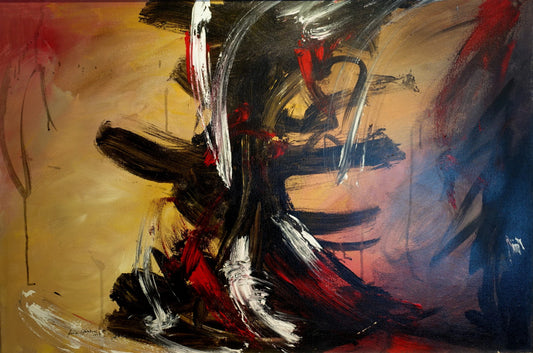Collection: Frère Jérôme
-
Frère Jérôme - Il fut un temps / Mixed Technique/Panel, 1969, 19X24.75 in // 48.26X62.865 cm
Vendor:Galerie NuancesRegular price $0.00Regular price -
Frère Jérôme - Untitled / Mixed Technique/Canvas, 24X36 in // 60.96X91.44 cm
Vendor:Galerie NuancesRegular price $0.00Regular price -
Frère Jérôme - Untitled / Oil/Paper, 1978, 24×40 in // 60.96×101.06 cm
Vendor:Galerie NuancesRegular price $0.00Regular price
Request for information
Frère Jérome, a great abstract artist
A great Canadian master, painter, professor, and educator, Brother Jérôme was born in Charlesbourg in 1902 (died in 1994). He studied at the École des beaux-arts de Montréal from 1936 to 1938. He is a leading figure in abstract art in Quebec, owing to the originality of his artistic and avant-garde work.
The unique works of Frère Jérome
"Under his baptismal name, Joseph Ulric-Aimé Paradis entered the Congregation of the Holy Cross very early in his life. He became frère Jérôme in 1918. He was certainly an important painter of our modernity. But he was much more. An extraordinary communicator, this pedagogue offered workshops that were phenomenally successful. Associated with pictorial modernity and the new ideas it generated, even a fervent defender, he was part of all the demands of the 1940s, which is quite surprising, you will agree, for a clergyman. At the time, the wind of aesthetic and ideological reforms was blowing very strongly in often heated minds. The camps were rising: Prisme d'Yeux, Refus global… Brother Jérôme found great motivation in these demands and was sympathetic to all, close to both Borduas and Pellan. His teaching is revolutionary in many ways and, as in his painting, freedom and the search for oneself, for one's hidden inner side, remain fundamental leitmotifs of his expression. For him, automatism constitutes the gateway. » Robert Bernier
A Quebec artist, frère Jérôme's works are part of many public and private collections in Quebec and Canada.
ADDITIONAL ARTICLE(S):
Frère Jérôme (1902-1994)
Frère Jérôme’s contribution to the adventure of modern art in Quebec is often underestimated. There is nothing trivial about his career. Religious, painter and teacher, he met Paul-Émile Borduas in the 1940s, while he taught drawing and painting at Notre-Dame college. Frère Jérôme finds in Borduas’ thought an inexhaustible source of inspiration and motivation that will guide his action until the end of his life. If one considers his religious status and the social context of the time, his relationship with Borduas and the inspiration he derives from it seem unusual. His ideas and teaching methods are far from the conventions generally accepted in an institution like the one where he teaches. What is more, his position on the manifesto of the Global Refusal, which, let us not forget, is an unequivocal charge against ecclesiastical power, appears to be the most controversial testimony. However, despite his many differences of opinion with the members of his religious community — if he was sometimes marginalized within, he was never forbidden to express his ideas — and his fragile health which imposes on him periods of forced rest, frère Jérôme pursues his artistic and educational activities with the same determination.
Frère Jérôme makes no distinction between his artistic production and his teaching. For him, it is an inseparable whole, art being first of all a state of mind, a way of living. The goal of the workshops he led until 1967, at Notre-Dame College, then in the Côte-des-Neiges district, was not to train artists. Brother Jérôme was interested in the development of the individual through creativity, a fundamental nuance which places his conception of art beyond the dogmas and conventions of society and the artistic milieu. Thus, this rather frail and nevertheless go-getter man will always be a rebel, contesting everything that hinders his artistic convictions. A black sheep of his community and of the official artistic milieu, he will touch through his workshops several thousand people who will find in him an open-mindedness, like no other.
Attempting to pierce the subconscious and to penetrate the deep individuality of each being was the basis of the global approach of this man animated by a powerful intuition and by a surrealist spirit with social reach. In a way, the action of Brother Jérôme joins that of Fritz Brandtner and Marian Scott, both very active in the 1940s, in setting up art workshops for children from underprivileged neighborhoods. Of course, frère Jérôme did not meddle like them in political matters, but his action contributed to a certain revolution of the mind and to a real democratization of art. This extraordinary painter died in 1994 at the age of ninety-two.
Source : Robert Bernier, La peinture au Québec depuis les années 1960, Les Éditions de l’Homme, 2002, Frère Jérôme (1902-1994), pages 16-17.



